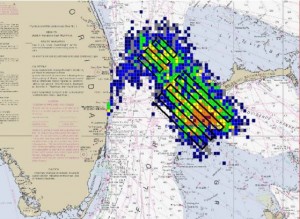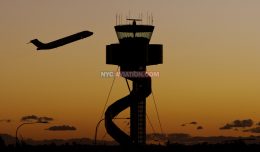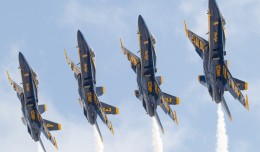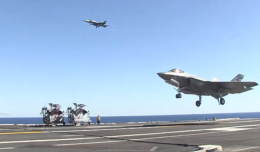A siren’s call wakes up a sleeping boat crew. The crew rushes to the boats as a HH-60 Jayhawk crew begins its pre-flight checks. The boat crew teams up with an 87-foot patrol boat and exchanges what little information is known at that point, as both vessels run at the greatest speed allowed by safety and weather conditions. The information is always convoluted at first; a possible plane crash some distance offshore. When the search and rescue (aka “SAR”) alarm goes off, you never really get the full picture. Information trickles in gradually. The type of air-frame, its point of origin and destination and how many souls on board; those details come after assets are deployed. The first bit of information a U.S. Coast Guard boat crew receives in a SAR case is what happened and where did it happen.
 A plane or helicopter crash in the ocean brings with it many challenges not encountered during a land search and cooperation is integral. The first, and most obvious, is the vastness of the ocean and how difficult it is to spot something in it. The second, and probably most important, is that the ocean is always moving. The object you are searching for will never be in its last known position. This is known as “datum,” or the most probable location of the search object corrected for movement over a period of time. One way datum is established is by using a drifting search pattern. A small buoy is placed in the water and a search pattern is performed; after the pattern is completed, set and drift are calculated. Generally, in cases of a crash, there is a fair amount of wreckage that is floating and that wreckage is actually the best source for determining datum and that information can assist in the rescue, or recovery, of passengers.
A plane or helicopter crash in the ocean brings with it many challenges not encountered during a land search and cooperation is integral. The first, and most obvious, is the vastness of the ocean and how difficult it is to spot something in it. The second, and probably most important, is that the ocean is always moving. The object you are searching for will never be in its last known position. This is known as “datum,” or the most probable location of the search object corrected for movement over a period of time. One way datum is established is by using a drifting search pattern. A small buoy is placed in the water and a search pattern is performed; after the pattern is completed, set and drift are calculated. Generally, in cases of a crash, there is a fair amount of wreckage that is floating and that wreckage is actually the best source for determining datum and that information can assist in the rescue, or recovery, of passengers.
 The science of SAR has also progressed. New computer programs can calculate drift and formulate search patterns and assign them to individual search units. Satellites, GPS, radio distress beacons, emergency position-indicating radio beacons (aka “EPIRB”) and even cellular phones can be used to assist in determining where a search should begin. Back on shore, in a command center located at a base called a sector, the search coordinator extrapolates all the data and tasks different units to assist in the search. This is determined by variables such as the location of the search as well as the size of the area to be searched. The Coast Guard assets include helicopters like the HH-60 Jayhawk and the MH-65 Dolphin. Fixed-wing aircraft utilized during SAR efforts are C-130 Hercules and HC-144A Ocean Sentry Medium Range Surveillance aircraft. Multiple cutters are tasked with search and recovery of wreckage for investigative efforts, while small boats are either launched from cutters or from shore (if the last known position is close enough to shore). The largest or highest-ranking cutter is usually designated as being in charge of the individual units involved in the search. Some small boats and aircraft could be equipped with forward-looking infrared cameras, while all assets are equipped with radar and a few sets of eyes. The U.S. Navy, Marine Corps., Air Force or even another country’s
The science of SAR has also progressed. New computer programs can calculate drift and formulate search patterns and assign them to individual search units. Satellites, GPS, radio distress beacons, emergency position-indicating radio beacons (aka “EPIRB”) and even cellular phones can be used to assist in determining where a search should begin. Back on shore, in a command center located at a base called a sector, the search coordinator extrapolates all the data and tasks different units to assist in the search. This is determined by variables such as the location of the search as well as the size of the area to be searched. The Coast Guard assets include helicopters like the HH-60 Jayhawk and the MH-65 Dolphin. Fixed-wing aircraft utilized during SAR efforts are C-130 Hercules and HC-144A Ocean Sentry Medium Range Surveillance aircraft. Multiple cutters are tasked with search and recovery of wreckage for investigative efforts, while small boats are either launched from cutters or from shore (if the last known position is close enough to shore). The largest or highest-ranking cutter is usually designated as being in charge of the individual units involved in the search. Some small boats and aircraft could be equipped with forward-looking infrared cameras, while all assets are equipped with radar and a few sets of eyes. The U.S. Navy, Marine Corps., Air Force or even another country’s  military can assist in the search of an aircraft in the ocean, each providing its own special set of skills and resources. As was the case with TWA flight 800, Navy salvage divers brought wreckage to awaiting barges. In the case of the miracle on the Hudson, Coast Guard, police, fire and even civilian vessels pulled up to the aircraft and recovered survivors.
military can assist in the search of an aircraft in the ocean, each providing its own special set of skills and resources. As was the case with TWA flight 800, Navy salvage divers brought wreckage to awaiting barges. In the case of the miracle on the Hudson, Coast Guard, police, fire and even civilian vessels pulled up to the aircraft and recovered survivors.
Unfortunately, not all plane crashes can be miracles. Generally, once wreckage is discovered, a focused search is conducted in the area of that wreckage for those who were aboard. Should passengers be recovered, the greatest care is taken to respect the bodies. Wreckage floating on the surface is also collected if it is safe to do so.
The Coast Guard has been the premier U.S. maritime agency since 1790, and its hardworking members have been and continue to be semper paratus, or “always ready.”
George C. Damanis is a Financial News Reporter for theflyonthewall.com and a veteran of the U.S. Coast Guard since July, 2001. He left active duty in 2010 and is currently a reservist at Coast Guard Station Philadelphia. He has been involved in many search and rescue cases including some plane and helicopter crashes, as well as working at Ground Zero in 2001.







